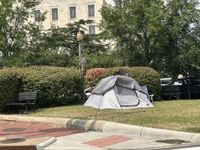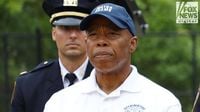In a dramatic escalation of federal involvement in local crime prevention, President Donald Trump has launched an aggressive crackdown on crime and homelessness in Washington, D.C., deploying the National Guard and federal agents to the nation’s capital. The sweeping initiative, which began in early August 2025, has already resulted in hundreds of arrests, large-scale weapons seizures, and the removal of dozens of homeless encampments from city streets and federal land. The move has sparked a national conversation about the balance between federal and local authority, as well as the most effective strategies to address urban crime and homelessness.
According to Fox News, the White House reported that 68 people were arrested in Washington, D.C., on the night of August 16 alone. The charges ranged from aggravated assault and assault on a police officer to resisting arrest, fugitive from justice, felony grand larceny, and possession of a controlled substance. Law enforcement also seized 15 illegal firearms during the operation. Since the crackdown began on August 7, a total of 308 arrests have been documented, including 135 individuals identified by the White House as illegal immigrants with alleged ties to gangs or violent criminal activity.
"In less than ten days, over 300 dangerous criminals have already been arrested and taken off the streets of Washington, D.C.," White House spokesperson Taylor Rogers told Fox News Digital. She emphasized the scale and urgency of the operation, stating, "Over 300 arrests in D.C. — and counting: Just last night, our federal and DC law enforcement partners made 68 arrests and seized 15 illegal firearms. Homicide suspects, drug traffickers, and more are being charged. I’ll continue to stand with you as we make DC safe again!"
The operation has not been limited to arrests. On August 16, three homeless encampments in the city were cleared without incident or arrests, according to a White House official. The Department of the Interior also announced a new zero-tolerance policy for homeless encampments on federal land, part of a broader effort to "clean up the city" and restore order. Since President Trump signed the "Making the District of Columbia Safe and Beautiful" executive order in March, more than 75 homeless camps have been removed from D.C., as reported by the New York Post and NewsNation. On August 12, federal officials announced plans to remove the last two encampments from district parks, signaling an intent to bring the city’s homelessness crisis under tighter federal control.
Interior deputy press secretary Aubrie Spady highlighted the administration’s commitment, saying, "President Trump signed the order to Make D.C. Safe and Beautiful in March, and our dedicated U.S. Park Police have been working around the clock since to enforce this directive, clean up our streets, and ensure our nation’s capital is safe."
The high-profile crackdown comes just a week after President Trump publicly vowed to restore Washington, D.C., to its former glory. In a Truth Social post, he promised, "I will take care of our cherished Capital, and we will make it, truly, GREAT AGAIN! Before the tents, squalor, filth, and crime, it was the most beautiful Capital in the world. It will soon be that again." The deployment of the National Guard and the federalization of the Metropolitan Police Department on August 17 marked a significant expansion of federal authority in local law enforcement, a move that has drawn both praise and criticism from various quarters.
Meanwhile, in New York City, Mayor Eric Adams has faced his own set of challenges following a fatal shooting in Crown Heights, Brooklyn. On August 18, Adams announced the expansion of the NYPD’s Quality of Life Division across Staten Island, a program designed to address homeless encampments, outdoor drug use, noise complaints, and other public safety issues. The announcement came just a day after the Brooklyn shooting, which left 14 victims identified, including three fatalities.
Despite the timing, Adams was quick to distance his initiative from the Trump administration’s efforts in Washington, D.C. Speaking to Fox News Digital, Adams asserted, "As we indicated over and over again, we got this. Our numbers speak for themselves." He emphasized that the city’s approach was independent of federal intervention, stating, "Our numbers are clear. We're willing to share what we're doing successfully here with other cities, and we've done that before." Adams, who is running for re-election as an independent, added, "We are an example of what all cities can do, but we're not responding to some of the things that we're reading about this," referencing the federal crackdown in D.C.
The NYPD has reported record-low shootings and murders during the first five months of 2025, with May being described as the "safest in recorded history for shootings and murders." However, Adams acknowledged that the city still faces significant challenges, particularly regarding the influx of illegal firearms. He called for "assistance on the federal level to deal with the flow of illegal guns onto our streets," noting the impact of out-of-state offenders: "When a person who drives across the country and creates havoc with an illegal gun, like the suspect in the Midtown shooting, it really hurts these inner cities."
Since its launch on April 14, the NYPD’s Quality of Life Division—also known as Q-Teams—has made what Adams and NYPD Commissioner Jessica Tisch describe as "significant improvements to New Yorkers' quality-of-life concerns." Yet, not all residents are convinced. At the Staten Island announcement on August 18, several locals confronted Adams with complaints about building maintenance and living conditions. One woman described floors that hadn’t been mopped, uncollected garbage, broken elevators, and a lack of hot water in her building. Adams responded by encouraging the formation of a tenants’ association and promised to arrange a meeting to address their grievances.
While New York City’s leadership insists on the effectiveness of local strategies, the events in Washington, D.C., have reignited the debate over the role of federal government in urban crime policy. President Trump’s supporters argue that only a robust federal response can address the scale of crime and homelessness plaguing the capital, pointing to the rapid results of the recent crackdown. Critics, however, warn that bypassing local authorities risks undermining community trust and may not address the root causes of urban disorder.
As both cities wrestle with crime and homelessness, their divergent approaches reflect broader national tensions over policing, public safety, and the responsibilities of federal versus local government. The coming months will test whether Washington’s new zero-tolerance policies and New York’s community-focused reforms can deliver on their promises of safer, more livable cities—or whether the challenges of America’s urban centers will require a new kind of partnership altogether.

